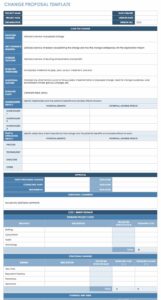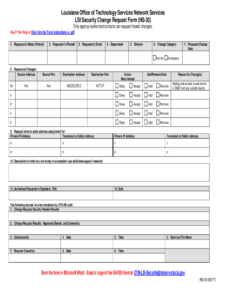Utilizing such a document offers significant advantages. It improves communication among stakeholders, facilitates risk assessment and mitigation, enhances change management efficiency, reduces downtime and service disruptions, and strengthens audit trails for compliance and regulatory requirements. A well-defined process fosters better control over network infrastructure and minimizes the potential for unintended consequences.
Understanding the components and purpose of these documented procedures is essential for effective network management. The following sections will delve into the key elements typically included in such documentation, as well as best practices for its creation, implementation, and ongoing maintenance within an organization’s change management process.
Key Components of a Network Change Request
Effective change management relies on comprehensive documentation. A standardized change request form ensures all necessary information is captured for thorough assessment and implementation.
1. Change Identifier: A unique tracking number for easy reference and follow-up.
2. Requestor Information: Details of the individual or team initiating the change.
3. Change Title and Description: A concise summary of the proposed modification.
4. Justification and Business Impact: The reason for the change and its anticipated effects on operations.
5. Scope and Affected Systems: Clear identification of all network devices, services, and users impacted.
6. Implementation Plan: Detailed steps for executing the change, including timelines and assigned personnel.
7. Rollback Plan: Procedures to revert the change if problems arise during or after implementation.
8. Testing and Validation: Methods to verify the success and stability of the change.
9. Approval Workflow: Designated individuals authorized to review and approve the request.
These elements provide a framework for clear communication and control, ensuring all stakeholders understand the change, its potential impact, and the steps involved in implementation and validation. Thorough documentation minimizes risk and contributes to successful network modifications.
How to Create a Network Change Request Template
Developing a standardized template ensures consistency and completeness in documenting network modifications. A well-designed template facilitates clear communication, simplifies the request process, and improves change management efficiency.
1. Define Scope and Purpose: Determine the types of changes the template will cover. Consider the specific needs and complexity of the network environment.
2. Identify Required Information: Specify the essential data points to be captured, including change details, justification, impact assessment, implementation plan, rollback procedures, and approval workflows. Refer to industry best practices and regulatory requirements.
3. Design the Template Structure: Organize the template logically with clear headings and sections. Use tables or forms for easy data entry and readability. Consider using dropdown menus or checklists for standardized options where applicable.
4. Incorporate Approval Workflows: Clearly define the roles and responsibilities for reviewing and approving change requests. Integrate the template with existing change management processes and systems.
5. Implement Version Control: Establish a system for managing template revisions and updates. Maintain a clear history of changes to the template itself.
6. Train Personnel: Provide comprehensive training on how to use the template effectively. Ensure all stakeholders understand the importance of accurate and complete information.
7. Regularly Review and Update: Periodically evaluate the template’s effectiveness and make necessary adjustments based on feedback and evolving needs. Ensure alignment with current best practices and organizational policies.
A standardized, well-defined template provides a structured framework for proposing and documenting network changes. This facilitates efficient communication, reduces errors, and contributes to the successful implementation and management of network modifications.
Effective management of network infrastructure relies on structured processes for implementing modifications. Standardized documentation provides a crucial framework for planning, communicating, and executing changes safely and efficiently. From initial request through approval, implementation, and validation, a well-defined process minimizes risk, reduces downtime, and ensures changes align with business objectives.
Organizations must prioritize the development and implementation of robust change management procedures. Consistent use of standardized documentation enhances operational efficiency, strengthens security posture, and supports compliance with industry regulations. Embracing a proactive and structured approach to network modifications is essential for maintaining a stable, secure, and reliable network infrastructure in today’s dynamic technological landscape.


